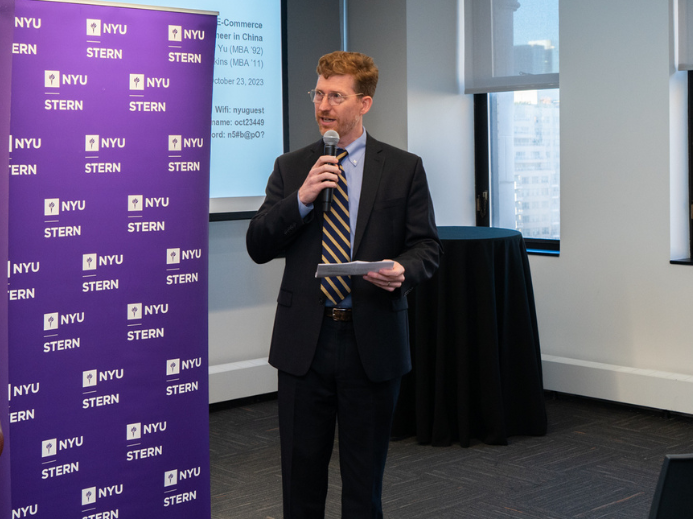Thinking about Generative AI: A Discussion with Professor Robert Seamans

Few topics have aroused as much interest and discussion in the world of business and technology as generative artificial intelligence (GenAI). At the forefront of these discussions is Stern Professor of Management and Organizations Robert Seamans, whose expertise in the economic consequences of AI, robotics, and other advanced technologies has made him a go-to for business and government organizations looking to get a handle on how it can be safely incorporated into everyday lives.
Seamans, also director of the Stern Center for the Future of Management, has studied how GenAI and open-source technology will affect industries and jobs from economic as well as organizational, entrepreneurship and innovation, and labor perspectives. GenAI can take the form of language modeling, as in OpenAI’s ChatGPT, or image generation, both of which will have enormous impact on how work is done and what is required of skills training or retraining for industry to take full advantage of its time-saving and creative capabilities.
How this powerful technology can be regulated is an especially hot topic, which has policymakers and companies weighing its enormous potential against the risk of misuse or inherent vulnerabilities.
Q&A with Robert Seamans
Which industries do you believe will be most impacted by the rise in AI? What makes a job more likely to be affected by new technology?
The short answer is that the vast majority of industries and occupations will be impacted by artificial intelligence, much in the same way that computers and the Internet affected most industries and occupations. My co-authors and I have developed a methodology to assess which occupations and industries are most exposed to advances in artificial intelligence (AI). For language modeling, which is a type of generative AI that has been in the news thanks to the rapid adoption of OpenAI’s ChatGPT, occupations like teachers, lawyers, and judges are most exposed, at least according to our methodology.
However, just because an occupation is exposed, it doesn’t mean the occupation will disappear. Instead, there are likely to be changes to the nature of how work is done in the occupation, with an increased reliance on language modeling technologies to help perform work.
It's worth noting that language modeling is one type of generative AI. Another is image generation. According to the methodology I developed with my co-authors, a different set of occupations is more exposed to advances in image generation, including graphic designers and architects, chemical and civil engineers, and air traffic controllers. Again, it is unlikely that image generation will replace any of these occupations, but will probably change how work is done in those occupations, perhaps in dramatic ways.
Can you give us an example of how a job may evolve as a result of AI-driven innovations?
The most exciting applications are those involving generative AI, such as image generation or language modeling. There are many examples of people using these tools in new and creative ways to help them do their professional work, but it is too early to have much systematic evidence about how these technologies will change jobs in general. There is some emerging research suggesting that generative AI tools can help train people how to do their jobs. For example, a study of call center employees shows that generative AI tools helped workers do their job more efficiently, and was particularly helpful for less experienced workers.

How do you believe that policymakers should approach AI regulation? What areas of AI, if left unregulated or poorly regulated, pose the greatest risk to businesses or society?
There have been a number of calls to “regulate AI” in the US and in the EU. These are well-intentioned: people worry about harms from AI and want to prevent those harms from happening. While there may be harms from AI, there may also be benefits. However, regulating AI too soon, or with too heavy a hand, risks stifling innovation, and risks setting up regulation in a way that benefits incumbent firms and dissuades new entrants.
I think there are two broad categories of policy that would be helpful:
— Government statistical agencies should assess how firms are using generative AI and in which ways workers are being affected to better understand where the effects of generative AI may be positive vs. negative.
— Labor policies should be flexible and broad-based, not targeted at specific occupations or groups, at least initially.
Where do you think career opportunities will be plentiful in the workforce over the next 5-10 years?
I think it is useful to remember how many companies and how much wealth were created due to computers and the internet. We are going to see something similar with generative AI.
How to take advantage of this? If you are a risk taker, this will be a great time to start up a company or work at a startup. There will also be opportunities at consulting firms; many firms are going to want to know the best way to adopt and implement AI, how to reorganize their firms as a result of the new technology, and things like that. These firms will hire consultants to help them figure it out.
How should managers be thinking about skills training for their employees to prepare for future workflow changes that are driven by AI?
Right now there is lots of learning by doing. Managers should encourage their employees to experiment with these new technologies, and also have mechanisms in place so that employees can share what they find with their managers, and for the managers to share useful findings across other departments and employees.
